12 of our favorite retro digital dashboards, part one
We’ve been reminiscing about digital dashboards. It’s thanks to the customizable screens in the VW ID. 2all, which allow you display cool retro graphics from Volkswagens long gone.
For now, the ID. 2all is a concept, albeit one that previews an all-new, affordable electric car, due in Europe come 2025. We hope the retro displays make production and inspire other manufacturers to follow VW’s lead.
In the meantime, here are 12 digital dashboards from the 1980s and ’90s. Our shortlist was rather long, forcing us to focus on a dozen of our favorite production cars. Stay tuned for volume two, which may include a few concepts …
Aston Martin Lagonda
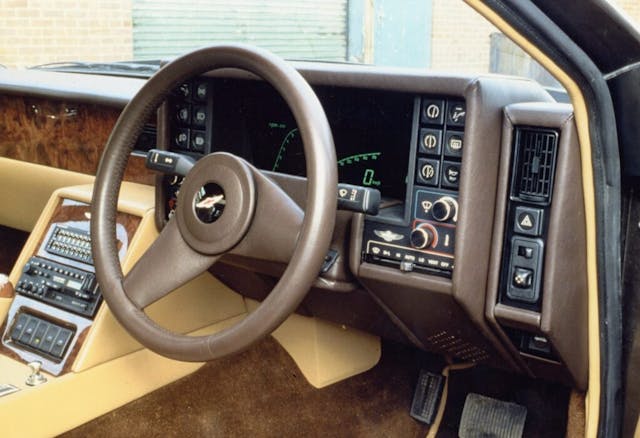
The Lagonda (Series 2) was the first car to be launched following the 1975 takeover by an American-Canadian consortium. Designer William Towns and chief engineer Mike Loasby led the project for the four-door super-saloon, which debuted as a prototype in October 1976.
Its advanced electronic instrumentation with graphic and digital solid-state displays were developed in conjunction with the Cranfield Institute of Technology, with Loasby reportedly influenced by touch-sensitive switches during a visit to the National Semiconductor HQ in California.
The electronics proved to be its undoing, with only 16 cars built during the first two years of production, forcing Aston Martin to relieve Cranfield of its duties in favor of Dallas-based Refoy. The gas-plasma display made way for digital instrumentation, followed by cathode-ray and Vacuum Fluorescent (VF) displays.
Nissan 300 ZX (Z31)
The Nissan 300 ZX optional Electronic Equipment Package would top many people’s list of the best digital dashboards. Because it’s Japanese, there’s a good chance that everything will still be working, even in 2023.
The speed was displayed both digitally and as a colorful bar chart, with the system also monitoring fuel, temperature and voltage via bars or digitally, depending on the function. Its tachometer was a particular highlight, especially on turbocharged versions, where the display indicated rpm plus boost.
To the right of the steering wheel were a pair of digital dials showing acceleration or instant fuel economy on the left, and a compass on the right. Almost everything was digital, right down to distance to empty and climate control temperature, which made the analogue odometer look comically dated.
Fiat Tipo DGT
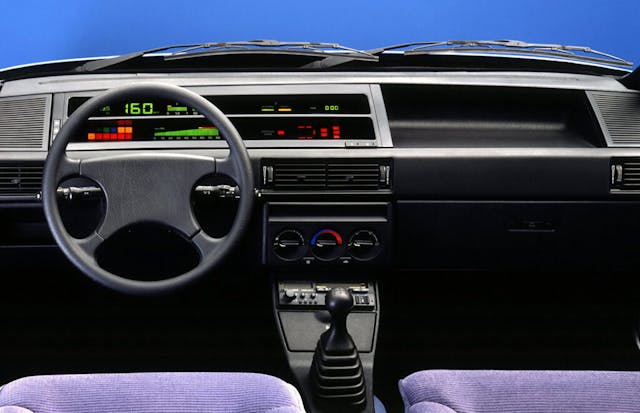
You can leave your jokes about Italian electrics at the door and admire the majesty of the Fiat Tipo DGT dashboard. We love the simplicity and clarity of the layout, along with—praise be—rotary dials and proper switches for the heating and ventilation.
We had seen digital instruments before, but where many manufacturers adapted existing instrument binnacles, Fiat went further by creating a bespoke dashboard for high-spec versions. Note the horizontal slots, which shrouded the digital displays to ensure they could be seen in bright sunlight.
Chris Goffey wasn’t a fan of Fiat’s digital display. In a 1990 Top Gear review of the Tempra, he said: ”With the SX version you get a rather garish electronic digital dashboard; personally, I’d prefer the simple analog instruments of the base version.” Ouch.
Honda S2000
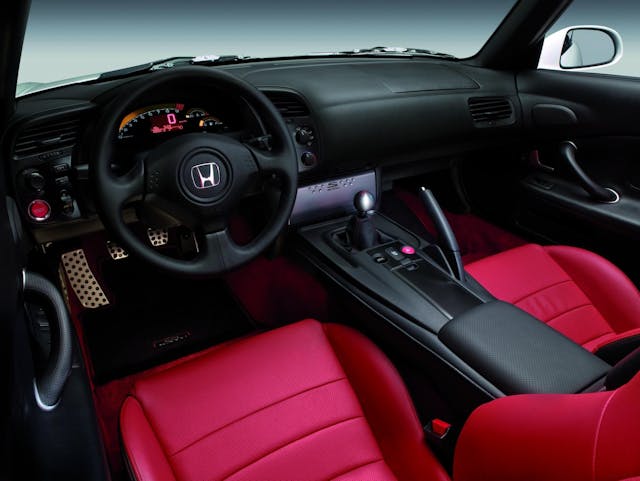
The S2000 wasn’t the first Honda to boast a digital dashboard. Earlier examples include the City Turbo II and the third-generation Accord in its domestic market. Yes, the one with the pop-up headlights, to create a double whammy of nostalgia. Maximum RADwood points available.
Alongside the Insight, the S2000 delivered digital joy to a new generation, arriving just before the turn of the millennium. It’s dominated by a sweeping rev counter with the red zone set at 9000 rpm, and the temperature gauge and fuel tank alongside it.
We like this line from Richard Meaden: ”I’d forgotten about the digital dashboard—what motoring journalists before my time would have quaintly described as ‘Tokyo by night’—and it’s lo-fit whiff of Atari or Texas instruments. In an age of retina displays and OLEDs it could look embarrassingly dated, but to be fair the instrument pack still looks surprisingly good and works well.”
Renault 11 TXE Electronic
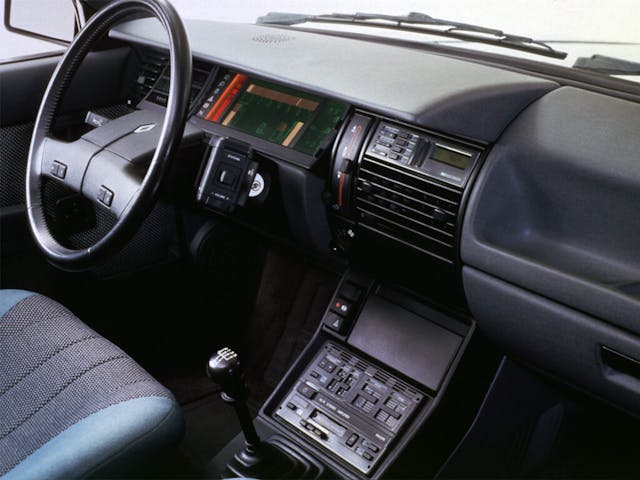
The Renault 11 TXE Electronic was the first European car to be fitted with a voice synthesiser, beating the Maestro by one week. We suspect Nicolette McKenzie, the actress whose voice brought the Maestro to life, would have something to say about that.
The button for the synthesizer was located alongside the digital dashboard, which featured a horizontal rev counter, digital speedometer and other information.
Jon Bentley had a play with Richard Benneworth’s 11 TXE Electronic at the 2018 Hagerty UK Festival of the Unexceptional. The digital man sounds like Charles from the 2022 comedy Brian and Charles.
Corvette C4
We’ve reached the midpoint of our trip down digital dashboard lane, and it’s occurred to us that a lot of these retro delights remind us of the Tomy Racing Turbo game from the 1980s.
Our minds are probably playing tricks on us, but the Corvette C4’s digital instruments take us back to those wasted minutes on the Tomy, which Argos described as “simulated driving fun.” Eat your heart out, Kazunori Yamauchi, aka Mr. Gran Turismo.
Unlike the Tomy, the C4 Corvette was pretty radical, becoming the first car to offer an electronic instrument cluster with three LCDs as standard. Everything you needed to know was available in an instant, until it wasn’t, at which point it became a pain to fix, leaving the driver in the dark.
Citroën BX 19 Digit
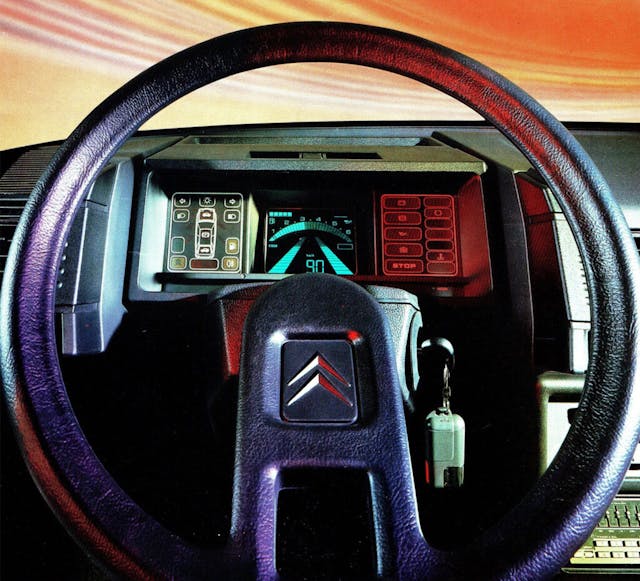
The Citroën BX 19 Digit was based on the BX 19 GT with what was dubbed a “super-electronic driving console.” Just 3000 were built for France and nine other countries from September 1985.
Our cup of eccentricity runneth over with this display of single-spoke wheel, satellite controls and digital instrument panel goodness. Note the digital and graphic display of the speed, along with what Citroën called an “engine overspeed warning.” (That’s rev counter to us.)
According to a press release from 1985, “electronics will be closely linked to the progress of the automobile for a long time to come. With this version, the BX reconfirms its modern image, and finds itself once again in the limelight of innovation.”
Cadillac Allanté
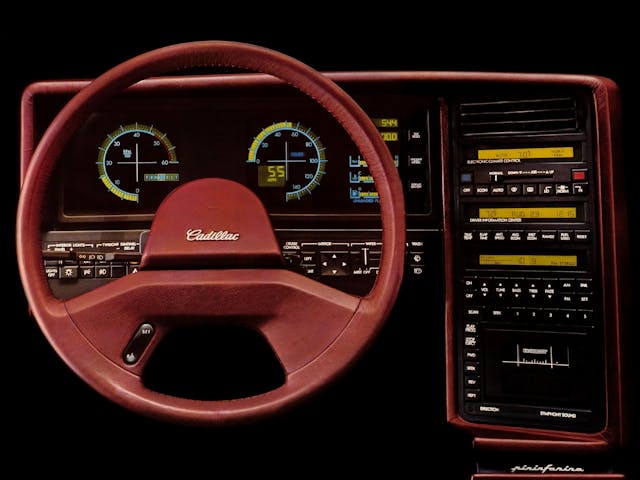
Remember the 1986–93 Cadillac Allanté luxury convertible? Using Boeing 747s, GM flew parts 4500 miles to Turin, where they were assembled into car bodies, trimmed and painted, then flown back to Detroit, 56 at a time, for final assembly. Few projects of the period were more extravagant.
The standard equipment was as indulgent as the build process, including an electric folding hardtop with three glass windows, Italian leather upholstery, a 4.1-liter V-8 and a four-speed automatic transmission for effortless boulevard cruising.
Even the LCD instrument panel was fitted as standard, although all-analogue gauges were available as an option if buyers were concerned about the Italian electronics. They needn’t have worried; the digital dashboard was the work of the Japanese company Yazaki.
Subaru XT Turbo
The Subaru XT Turbo featured one of the coolest digital displays of the 1980s. Why limit yourself to a basic digital speedo and rev counter when you can have something much, much cooler?
As an option, the XT Turbo featured a pictogram of a car flanked by “pavements” illuminated by boost and tachometer gauges. It was like a cross between Tron, the aforementioned Tomy Racing Turbo, and Lotus Turbo Esprit on the ZX Spectrum. A little 4WD icon was illuminated when you engaged four-wheel drive.
Allow Jason Cammisa to guide you through the (many) finer points of the Subaru XT. It’s the future we wish we had.
Buick Riviera

If you find yourself getting annoyed with a touchscreen in a modern car, you can unleash your fury on GM’s Graphic Control Center, which used a cathode-ray tube (CRT) with a green and black screen and was the first touchscreen available in a production car.
The system found its way into the Buick Reatta, along with the Oldsmobile Toronado as the Visual Information Center, but was dropped when users found it onerous and distracting. When Popular Mechanics reviewed the 1986 Riviera T-Type, it said “it violates the First Commandment of ergonomics – you must take your eyes off the road to make any adjustments.”
It was a false dawn for the touchscreen, but Buick pioneered tech that wouldn’t become mainstream for another decade-and-a-half.
Vector W8
Doug DeMuro called it “the craziest supercar ever made”, and although we’ll leave that debate for another day, the Vector W8 had one of the best digital screens of the 1980s. Just 17 customer cars were built, along with two prototypes.
There were four buttons, which enabled the driver to scroll through four menus: Main, Performance, Performance (again), and Chassis. As the name suggests, Main was for the primary functions: fuel gauge, speedometer and tachometer. Chassis was a bit misleading, because it let you know if you’d left one of the doors open!
The W8’s creator, Jerry Wiegert, wanted the Vector to exude the look and feel of a jet fighter, so he used aerospace switches and displays throughout the cabin. DeMuro was right, the W8 is the craziest supercar ever made.
Vauxhall Astra GTE
In 16-valve guise, the Mk2 Vauxhall Astra GTE was one of the most powerful hot hatches of the early 1990s, with its Cosworth-developed 1998cc “red top” engine producing 156 bhp. This alone should have been enough to tempt tearaways out of their souped-up Golfs, Escorts and 205s.
It had another ace up its sleeve in the form of a digital dashboard, which featured four gauges, a tachometer and speedometer. The digital speedo was famous for failing to keep up with the driver’s pace—something that affected other cars of the era, including the Audi quattro.
Speaking of which, should the Audi make our second list of digital dashboards? Let us know in the comments and feel free to nominate your favorite for inclusion.
***
Check out the Hagerty Media homepage so you don’t miss a single story, or better yet, bookmark it. To get our best stories delivered right to your inbox, subscribe to our newsletters.
Via Hagerty UK
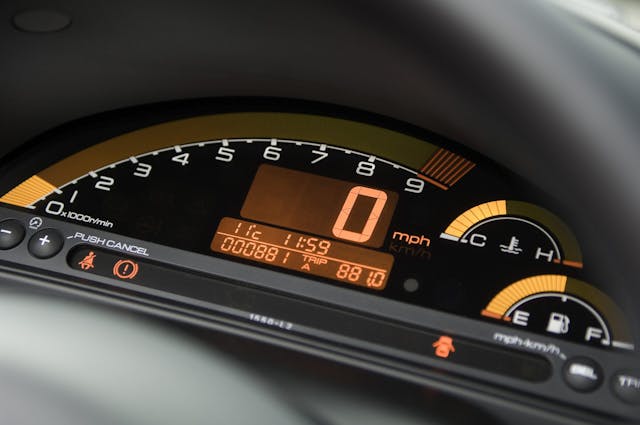


The Lagonda dash pictured is the vacuum flourescent one used in the series 4 cars. Is is pretty close in design to the corvette one shown later. Series 1 cars preceded the wedge shaped William Towns design, which are series 2 (LED), 3 (3 cathode ray tubes), and the softened series 4 (VF). A few series 3 cars received Marelli fuel Injection so may have the VF display too.
No digital instrumentation is cool in my book – and I certainly wouldn’t call it “retro”…
I agree w DUB6 – analog rules. the ’59 & ’60 Chev Impala and the Dodge rally dash in their ’68-’70 big cars are the cool ones
No! No! No! Digital is just a bad idea. Who wants to read things when you’re driving? All I need is a glance to see the location of the tach needle or the analog speedo. My 2002 Miata dash is darn near perfect except for the fake oil pressure gauge. And that Lagonda dash is sure to cause a few dozen rear-enders because the driver is looking to figure out what button to push.
I totally agree. Give me round analog gauges anytime!
Digital displays are unattractive and hardly retro. Just a bad idea that lives on in small doses.
Agree. If something goes bad in your digital display, the whole thing is junk. With analog, at least you have a chance.
Totally agree
Check out the 1984 Camaro Berlinetta. All digital no knobs. Cool pod radio on a swivel pole all push button. Before it’s time for a Camaro.
You forgot the 1983 Camaro Belinetta
I figured my Allante would make the list
Renault Avantime would be a suitable addition to this list, surely?
The S2000 dash was designed to resemble the dash of Ayrton Senna’s Williams MP4/6 F1 car. Same arc-shaped tach, same bar graph displays for temp plus/fuel, plus they added a digital display of speed (as it was a road car).
So Honda wasn’t looking to be futuristic, they were tying in to their F1 history with the S2000. Doesn’t look as tacky when viewed in this light, in my opinion.
When I bought my S2000, I wasn’t totally sure about the look of the dash. However, after fifteen years of ownership, I love it. I added a shift light to help the old guy get the gear changes right!
That would be a McLaren not a Williams which would complete the Honda circle. If you’ll remember, the Honda people dumped Williams because they would not take a Japanese driver (Crashajima) for the ’88 season. The engines went to Lotus for whom Senna drove for in ’88 before going to McLaren in ’89. Senna would drive a Williams in ’94 and crash at Imola.
Yes, Maclaren.
Thank you!
I could see how the S2000 instrumentation might look “tacky” from the outside looking in. But spend any amount of time driving the car, and you will appreciate its functionality and ease of use. I absolutely love that sweeping tach, and bet Senna did as well!
You forgot the 1990 ASC/McLaren/Pontiac Turbo Grand Prix and its’ wonderful “digital” nav screen and HUD. Besides, there were 118 (!) hard buttons in that interior.
In considering the purchase of a new Toyota GR86, one thing that gives me pause is its fully digital gauge cluster which seems destined for expensive failure. But this article reminds me that most of those Honda S2000 displays are still working well all these years later, so I probably don’t have much to worry about.
Never had an issue with my S2000, which I have owned for over fifteen years now. My son has a Civic Si with just about every available gadget on board. After six years of ownership, it’s still going strong.
3rd generation Trans Am had a nice digital display layout that most people didn’t know existed
Your right but I think it was in the later GTA Models. The Camaro Berlinetta also had a unique Digital Dashboard apart from the rest of the Camaro lineup with pods on either side of the dash and the radio was on a rotating stalk. Cool stuff.
Next, you’ll like the talking ones.
The 1988 Cutlass Supreme International had the nicest digital dash of them all!
I can’t believe you have an updated this article to include the 82-89 Mitsubishi Starion/ 84-89 Dodge Conquest!
I also had a mid 80’s Mitsubishi Galant with a very cool pod like dash with auto air ride and a stereo with equalizer! It was very futuristic!
This is very funny.
I suppose car reviewers these days aren’t old enough to remember digital gauges.
You also forgot the 1983 to 1988 (or 1989) Mercury Cougar dash.
The digital dash in the upper trim level S10 Pickup/Blazer was pretty cool too…. When it worked.
I had a 1990 S10 Blazer that had a Starcraft (think vans) conversion. With the whole exterior trim package in the interior covered in actual Teac wood.
Anyway, that digital dash display was pretty cool looking except in a year and a have that cluster was replaced three times. Thankfully all under warranty. Initially the various bar graphs (fuel, temp, oil pressure, Volts, etc) would fail. Twice, the whole cluster shorted out with the cluster going completely dark. No speedo, no nothing.
Personally, I’ve never been a fan of digital dash boards, even the well laid out ones. If the sun hit it right, difficult to see and if something goes wrong, can be more of a challenge to repair. But I have to admit, some of these do look nice.
Hummm. I’ve noticed that the radio display on my 2010 Tacoma disappears if I wear polarized sunglasses. I wonder if this is a larger problem with these displays?
Totally Agree !!